Monotube heating system: we find out the efficiency in
One-pipe heating system of a private house is more economical and simple in relation to the two-pipe system with the so-called “supply” and “return”. Knowing the rules of installation of such a heating system, you can arrange it in the best way, ensuring highly efficient operation and maximum energy saving. We will tell about all the nuances that you will encounter when using this type of heating.
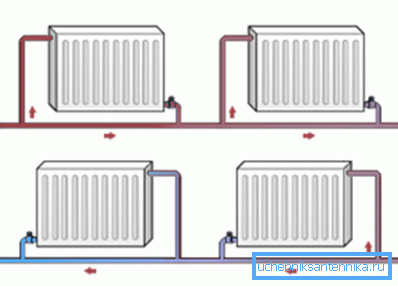
Components of the heating system at home
To begin with, we will analyze what the one-pipe and two-pipe heating systems consist of, this will help in the perception of the arrangement as a whole:
- Trunk pipeline, on which the heat carrier moves.
- Heating appliances (radiators) connected in necessary places to the highway.
- Coolant source (hot water) in the form of a boiler.
- Expansion tank.
- Elements for circulating coolant in the system.
Note! Most of the coolants differ in the volume of tanks and additional functions, as well as the materials used when laying.

Special features
Monotube heating system Leningradka is a closed loop of a single pipeline through which heat is supplied to radiators and, having washed them, returns to the boiler.
The method of heating a dwelling, thus, has a number of advantages that make it preferable in a private building:
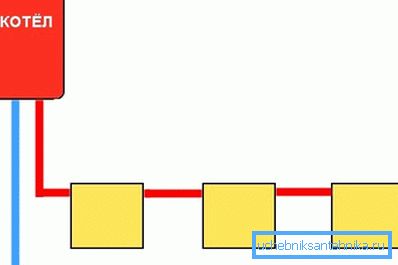
- Profitability in operation (in comparison with two-pipe versions).
- Low price, due to the lower consumption of materials.
- Easy installation and emergency repair. Most owners of country houses can independently arrange this option of heating.
- It is possible to lay the main pipeline directly above the floor, or to hide completely under it.
- The one-pipe system is equally effective in both one-storey and two-level houses.
Note! The optimal mode of operation of this heating equipment in all areas of the home is achieved by a properly selected sequence of radiator connections.

System circulation
The circulation of the coolant in the heating system can be:
- Natural, occurring due to the difference in the density of water. The cooled water from the reverse part of the circuit, which has a higher density, displaces the less dense (hot) to the top of the riser and pushes further into the main pipeline to the radiators.
Note! With this method of circulation pipes should be laid with a slope of not less than 3-5 degrees, which is not always possible in large houses with a large length of pipes. Indeed, with such a slope of the pipeline, the difference in height per meter length will be from 50 to 70 mm.
- Forced. In this method, the coolant is circulated by means of a pump connected to the heating system on the return circuit immediately before the water enters the boiler. The main pipeline in the system with forced circulation of the coolant can be laid with a height difference of 50 mm per meter of route length.
Attention! Since a system with a circulating pump connected to the power grid automatically becomes volatile, measures should be taken to avoid coolant stagnation at times of blackout. For this, a so-called booster collector is installed, capable of pushing hot water to a height of about 1.5 meters.
Expansion tank
At the peak of the accelerating collector, the pipeline is discharged into the expansion tank. Its purpose is to regulate the pressure in the heating system in order to avoid an increase to an emergency one.
Today, more often use expansion tanks closed design, excluding contact of the coolant with air.
Structurally, the expansion tank is a container divided into two parts by a flexible membrane:
- One is filled with air under pressure.
- The other is provided with an input-output coolant.
A closed expansion tank can be installed in any convenient place of the heating circuit, which is an advantage over open tanks mounted exclusively at the highest point of the system.
Note! Free contact of the coolant with air in an open expansion tank promotes active oxygen saturation. This threatens the early failure of steel pipes and heating devices because of the acceleration of corrosion processes. In this case, the installation of a monotube heating system with polypropylene pipes is preferable - the material is resistant to deformation.
Installation scheme of the components of the heating system
One pipe heating system is mounted in the following sequence:
- The source of heat carrier is a boiler capable of operating due to:
- Strip.
- Solid fuel.
- Electricity.
- Combinations of two or more possible fuel options.
Note! The latter option is convenient for those cases when at a certain time one of the sources of fuel is unavailable or becomes expensive.
- Accelerating collector with the entrance to the expansion tank. (See also the article Pipe cutter for steel pipes: features.)
- The main pipeline, bypassing in turn all the premises of the dwelling. Bearing in mind that the coolant cools as it moves away from the boiler, mainly the rooms that need better heating should be the first ones on the way to it:
- Baby.
- The bedrooms.
- Bathrooms.
Note! You are free to install radiators in your home in any convenient places. The only thing that is required by the installation instructions for heating devices is the mandatory installation under the windows. And our recommendations are also to locate radiators near the entrance door (in the next photo).
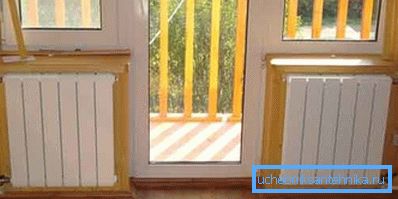
Connecting radiators
There are two ways to connect heaters to the system:
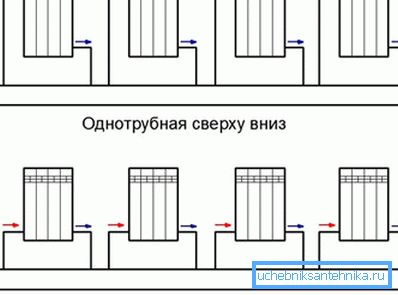
- The first - unregulated simple. Radiators in this case are connected to the highway at two points:
- At the entrance.
- At the exit.
This simple and inexpensive wiring diagram without additional connections and elements does not allow to perform:
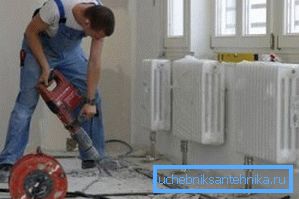
- Adjustment of the heating.
- Shutting down the radiator for repair or replacement when the system is full.
- The second option is Leningradka. According to this scheme, each radiator at the point of entry and exit to the highway is equipped with a locking device, with which you can:
- Regulate the power of heating in a separate area.
- Completely cut off the flow of coolant to perform repairs.
In addition, bypassing the radiators, a bypass with a locking device is mounted, if it is blocked, the flow of coolant is redirected directly through a specific radiator.
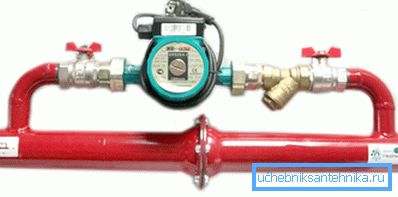
Do not forget that only you choose one of the above methods based on the features of each of them. There is another option - to hire a work crew who will determine the best heating system by the type of your building, after which you can begin to do your own hands. (See also the article Sewage in the cottage: features.)
Conclusion
Now you know more about the particularity of a one-pipe heating system, what are the options for its implementation in a country house. As you understand, the solution to this issue should be approached judiciously, after weighing all the pros and cons, you should understand what is best for you and your building. Be sure to compare with the two-pipe system, which is also popular in private homes.
In the presented video in this article you will find additional information on this topic.